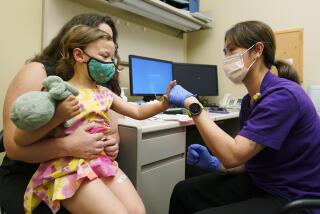MDs, Nurses, Learn to Deal With the Pain : Health: Those at a conference in Irvine are shown the latest pediatric techniques--medical and non-medical--to relieve suffering of young patients.
- Share via
IRVINE — The sight of a toddler blowing a storm of bubbles while ignoring a doctor who was inserting a needle in her arm sent a ripple of laughter Saturday through an audience of Orange County nurses and physicians who watched the procedure on videotape.
Encouraging children to blow bubbles is part of a broad arsenal of medical and non-medical methods, including narcotic-laced lollipops, self-hypnosis or simply the company of a friendly dog, that are being used to help youngsters cope with pain.
About 80 medical professionals gathered at an all-day conference at the Atrium Marquis Hotel in Irvine to learn about the latest in pain control and the need for increasing attention to pediatric pain--the extent of which has only been acknowledged within the last decade by national associations of pediatricians and anesthesiologists.
“Up until fairly recently, there were major pediatric centers in the country that did major surgery on newborns with little or no anesthesia,” said Dr. Robert Truog, associate professor of anesthesiology and pediatrics at Harvard Medical School and one of the conference speakers. There is now sufficient scientific evidence, the speakers said, to firmly disprove the once widespread belief that newborns cannot feel pain or that painkillers are too dangerous to administer to children. “In most cases there is good evidence now that pain control promotes healing,” said Truog.
The pain of newborns has been most neglected in part because physicians have had difficulty assessing their suffering, said Dr. Robert Wilder, director of the Pain Treatment Center at Children’s Hospital in Boston. After all, infants can’t speak up, and a baby’s crying can be misinterpreted as a call for food or attention.
But Wilder said research shows that a reliable indicator of an infant’s pain is facial expression, such as a grimacing mouth and a furrowed brow.
“Around the country, still half of the circumcisions are done without any anesthesia or pain medication,” he said.
Several speakers said improvements in the management of pediatric pain from illnesses and medical treatments will ultimately be brought about by the demands of parents.
“There will be parents who will take this as a battle cry and go to bat for their children,” said Leora Kuttner, a clinical psychologist and assistant professor in the department of pediatrics at the University of British Columbia.
Kuttner said parents are getting more involved in all aspects of the hospital care of their children. “Whereas parents 20 years ago would drop the children in the ward and come only during visiting time, now they are often staying at their children’s bedside,” she said.
The presence of a parent comforts a child, Kuttner said. During a painful procedure, she said, a parent can hold the child’s hand, tell stories or lead the child in taking deep, rhythmic breaths, all of which can be pain relieving.
And being with the child, Kuttner added, gives the parent an opportunity to act as the child’s advocate.
Dr. Robert L. Manniello, medical director of Children’s Hospital of Orange County, said the hospital’s staff is in the process of upgrading its pain management program in response to complaints received from parents and nurses.
A survey of the hospital’s 600 staff physicians found that many physicians, including surgeons, didn’t understand the importance of treating pain in children or know the most current pain control methods, Manniello said.
Saturday’s conference was organized by CHOC with a $6,000 grant from Abbott Laboratories. Manniello said the program is a first step toward better educating nurses and doctors. About half of those who attended the conference were CHOC staff members.
In addition, he said, the hospital is creating a pain management team that includes nurses, pediatric surgeons, and pediatric physicians and will set policies and procedures for pain management in every department.
CHOC already has tried some innovations, Manniello said, including the introduction this year of a pet therapy program.
Manniello told about David, a 10-year-old who died of cystic fibrosis at the hospital several weeks ago. In one of David’s last coherent moments, he received a visit from a German shepherd named Becks that he had come to love.
“David opened his eyes, and the dog came up and barked to say hello, and David petted him,” Manniello said. “It gave David five minutes away from his pain and anguish. At that point, the pain was gone.”






